David's Astronomy Pages
CCD Images - Session 1187 (2024-02-20)
Images
(S1186)
Images
Main
Home
Page
Images
(S1188)
David's Astronomy Pages
|
Images (S1186) |
Images Main |
Home Page |
Images (S1188) |
| 32P/Comas Sola - 2024-02-20 (passing through Aries) Sun Distance 2.09 AU (receeding) Earth Distance 1.95 AU (291.1 million km) |
32P/Comas Sola - 2024-02-20 Detail Autoguided on offset star using PHD2 with Lock Shift set at the comet's rate of motion (Ra 59.99 arcsec/hr, Dec 19.32 arcsec/hr) |
|
 |
 |
|
| Annotated CCD Image (50% size, square root scale) 2 x 90s exposure (average combine), 3x3 binning, Clear Filter 2024-02-20 23:57 UT (#1187100-01) 12" LX200R (at f/10.4) + ST-10XME Auto-guided using TS 80mm APO, ZWO ASI178MC & PHD2 |
Annotated CCD Image (100% size, square root scale, cropped) 5 x 90s exposure (average combine), 3x3 binning, Clear Filter 2024-02-21 00:01 UT (#1187100-04) 12" LX200R (at f/10.4) + ST-10XME Auto-guided using TS 80mm APO, ZWO ASI178MC & PHD2 |
|
| Images of 32P/Comas Sola on Comets 2023 Page >> | ||
| Images of 32P/Comas Sola on Comets 2024 Page >> |
Back to Top
| 62P/Tsuchinshan - 2024-02-21 (passing through Virgo) Sun Distance 1.44 AU (receeding) Earth Distance 0.52 AU (77.3 million km) |
62P/Tsuchinshan - 2024-02-21 Detail Autoguided on offset star using PHD2 with Lock Shift set at the comet's rate of motion (Ra -9.82 arcsec/hr, Dec 3.06 arcsec/hr) |
|
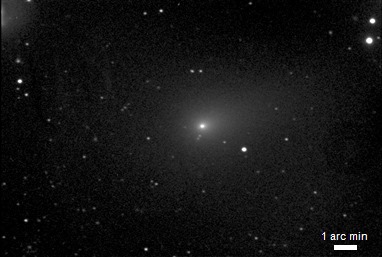 |
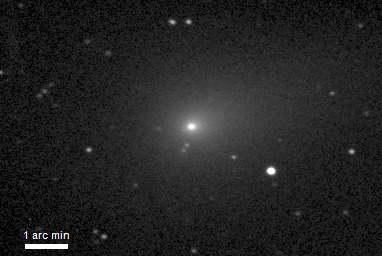 |
|
| Annotated CCD Image (50% size, square root scale) 7 x 90s exposure (average combine), 3x3 binning, Clear Filter 2024-02-21 01:20 UT (#1187131-37) 12" LX200R (at f/10.4) + ST-10XME Auto-guided using TS 80mm APO, ZWO ASI178MC & PHD2 |
Annotated CCD Image (100% size, square root scale, cropped) Image details as left |
|
| 62P/Tsuchinshan - 2024-02-21 Detail Light in top left corner is galaxy NGC 4608 |
62P/Tsuchinshan - 2024-02-21 Detail Light in top left corner is galaxy NGC 4608 |
|
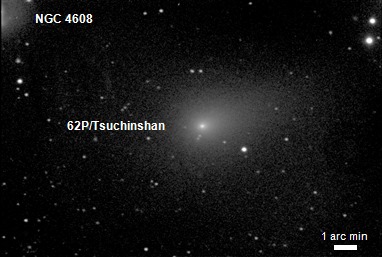 |
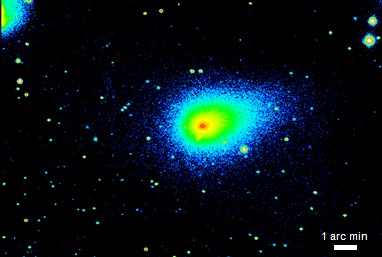 |
|
| Annotated CCD Image (50% size, log scale) 7 x 90s exposure (average combine), 3x3 binning, Clear Filter 2024-02-21 01:20 UT (#1187131-37) 12" LX200R (at f/10.4) + ST-10XME Auto-guided using TS 80mm APO, ZWO ASI178MC & PHD2 |
Annotated false-colour CCD Image (50% size, log scale) Inverse Spectrum Image details as left |
|
| Images of 62P/Tsuchinshan on Comets 2023 Page >> | ||
| Images of 62P/Tsuchinshan on Comets 2024 Page >> |
Back to Top
| 103P/Hartley - 2024-02-20 (passing through Monoceros) Sun Distance 1.95 AU AU (receeding) Earth Distance 1.07 AU (159.8 million km) |
103P/Hartley - 2024-02-20 Detail Autoguided on offset star using PHD2 with Lock Shift set at the comet's rate of motion (Ra -7.16 arcsec/hr, Dec 36.41 arcsec/hr) |
|
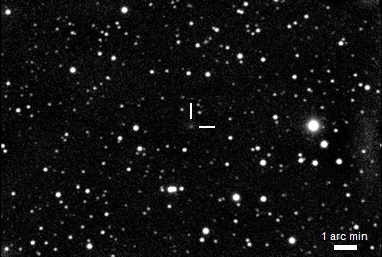 |
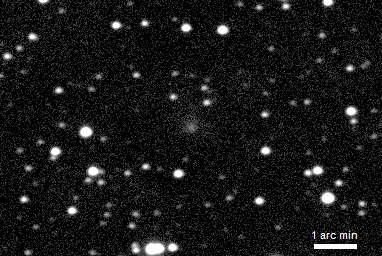 |
|
| Annotated CCD Image (50% size, square root scale) 3 x 60s exposure (average combine), 3x3 binning, Clear Filter 2024-02-20 21:33 UT (#1187037-39) 12" LX200R (at f/10.4) + ST-10XME Auto-guided using TS 80mm APO, ZWO ASI178MC & PHD2 |
Annotated CCD Image (100% size, square root scale, cropped) 9 x 60s exposure (average combine), 3x3 binning, Clear Filter 2024-02-20 21:37 UT (#1187037-45) 12" LX200R (at f/10.4) + ST-10XME Auto-guided using TS 80mm APO, ZWO ASI178MC & PHD2 |
|
| Images of 103P/Hartley on Comets 2023 Page >> | ||
| Images of 103P/Hartley on Comets 2024 Page >> |
Back to Top
| Nova Per 2020 (Perseus) Nova in Perseus discovered 2020/11/25.807 [ Novae ] Nova Per 2020 discovered independently by Seiji Ueda and Stanislav Korotkiy et al AT 2020abap (Type: CV) reported 2020/11/27.230 UT by PGIR Alias: N Per 2020 , PGIR20fbf, TCP J04291888+4354233, TCP J04291884+4354232, V1112 Per |
| Nova Per 2020 - 2024-02-21 (T+1182.2d) Image below (2024-02-21.008) was taken 1182.2 days after discovery of nova Nova (brightening ?) is shown by white cross hairs. Measured magnitude +16.36* (Clear Filter) * Measurement value is suspect |
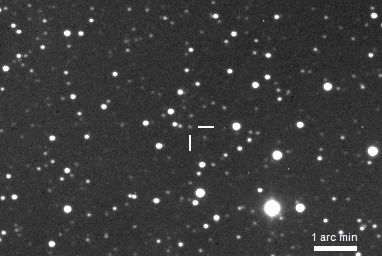 |
| Annotated CCD Image (100% size, linear scale, cropped) 5 x 120s exposure (average combine), 3x3 binning, Clear Filter 2024-02-21 00:18 UT (#1187107-11) 12" LX200R (at f/10.4) + ST-10XME Auto-guided using TS 80mm APO, ZWO ASI178MC & PHD2 |
| Images of Nova Per 2020 on Novae Page >> |
Back to Top
| AT 2023us (Hydra) AT 2023us (Type: unk) discovered 2023-01-16.937 UT by ATLAS Alias: ATLAS23avl Discovery Magnitude 16.47(cyan-ATLAS Filter) vs Previous Non-Detection Limiting Flux +19.5 ( TNS 2023us ) |
| AT 2023us - 2024-02-20 (T+400.0d) Image below (2024-02-20.929) was taken 400.0 days after discovery of 2023us Position of reported transient (ambiguous object ?, likely faded) is shown by white cross-hairs |
 |
| Annotated CCD Image (100% size, linear scale, cropped) 3 x 180s exposure (average combine), 3x3 binning, Clear Filter 2024-02-20 22:23 UT (#1187055-57) 12" LX200R (at f/10.4) + ST-10XME Auto-guided using TS 80mm APO, ZWO ASI178MC & PHD2 |
| AT 2023us - Detail 2024-02-20 (T+400.0d) Position of reported transient (ambiguous object ?, likely faded) is shown by white cross-hairs |
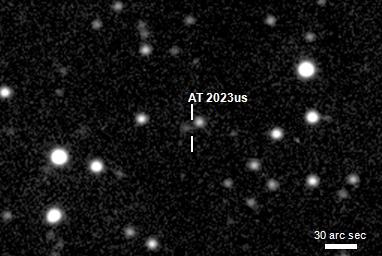 |
| Annotated CCD Image (150% size, square root scale, cropped) Image details as above |
| Images of AT 2023us on Transients 2023 Page >> |
Back to Top
|
AT 2023cub (Monoceros) |
|
AT 2023cub - 2024-02-20 (T+351.0d) Image below (2024-02-20.888) was taken 351.0 days after discovery of 2023cub Position of reported transient (fading) is shown by white cross-hairs Measured magnitude +11.87 |
|
|
|
Annotated CCD Image (100% size, linear scale, cropped) 4 x 60s exposure (average combine), 3x3 binning, Clear Filter 2024-02-20 21:22 UT (#1187030-34) 12" LX200R (at f/10.4) + ST-10XME Auto-guided using TS 80mm APO, ZWO ASI178MC & PHD2 |
| Images of AT 2023cub on Transients 2023 Page >> |
Back to Top
|
AT 2023aais (Monoceros) |
|
AT 2023aais - 2024-02-20 (T+65.9d) Image below (2024-02-20.848) was taken 65.9 days after discovery of 2023aais Position of reported transient (not visible) is shown by white cross-hairs Non-Detection Limiting Magnitude +17.2 (Clear Filter) |
|
|
|
Annotated CCD Image (100% size, linear scale, cropped) 5 x 60s exposure (average combine), 3x3 binning, Clear Filter 2024-02-20 20:24 UT (#1187007-11) 12" LX200R (at f/10.4) + ST-10XME Auto-guided using TS 80mm APO, ZWO ASI178MC & PHD2 |
| Images of AT 2023aais on Transients 2023 Page >> |
Back to Top
|
AT 2024crd (Virgo) AT 2024crd (Type: Nova?) discovered 2024-02-14.750 UT by Tadashi Kojima Alias: TCP J13530185+0522000, Gaia24apm Discovery Magnitude 13.2 (Clear Filter) vs Prior Non-Detection Limiting Magnitude 15.2 Transient on faint blue PanSTARRS source ( TNS 2024crd | Gaia24apm ) |
| AT 2024crd (T+6.3d) |
|
|
|
Annotated CCD Image (50% size, linear scale) 5 x 60s exposure (average combine), 3x3 binning, Clear Filter 2024-02-21 01:35 UT (#1187140-44) 12" LX200R (at f/10.4) + ST-10XME Auto-guided using TS 80mm APO, ZWO ASI178MC & PHD2 |
|
AT 2024crd - 2024-02-21 (T+6.3d) Image below (2024-02-21.064) was taken 6.3 days after discovery of 2024crd Position of reported transient (distinct) is shown by white cross-hairs Measured Magnitude +13.45 (Clear Filter) |
|
|
|
Annotated CCD Image (100% size, linear scale, cropped) 5 x 60s exposure (average combine), 3x3 binning, Clear Filter 2024-02-21 01:35 UT (#1187140-44) 12" LX200R (at f/10.4) + ST-10XME Auto-guided using TS 80mm APO, ZWO ASI178MC & PHD2 |
|
AT 2024crd - Spectra (T+6.3d) Unable to auto extract spectra: Rotate Image Fail Exception In RotateImage() - Index was outside the bounds of the array. Crop Image Fail Exception in CropImage() - Index was outside the bounds of the array. |
| TBA |
| 3 x 120s exposure (average combine), 3x3 binning, S Filter 2024-02-21 01:41 UT (#1187145-47) 12" LX200R (at f/10.4) + ST-10XME Auto-guided using TS 80mm APO, ZWO ASI178MC & PHD2 |
| Images of AT 2024crd on Transients 2024 Page >> |
Back to Top
| 2MFGC 08659 with SN 2023xyr (Ursa Major) SN 2023xyr (Type: Ia) discovered 2023-11-17.580 UT by ASAS-SN Alias: ASASSN-23if Discovery Magnitude 16.9 (g-Sloan Filter) vs Prior Non-Detection Limiting Magnitude 18.2 ( TNS 2023xyr ) |
| 2MFGC 08659 - Galaxy 2MFGC 08659 / PGC 2269876 (catalog mag +16.7 ) with other galaxies in FOV are PGC 33643 (catalog mag +15.3) PGC 213784 (catalog mag +16.0) Bright start in lower left of image is PPM 52253 (mag +9.9) |
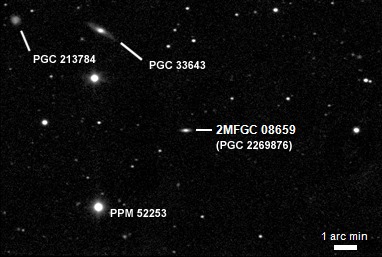 |
| Annotated CCD Image (50% size, square root scale) 5 x 180s exposure (average combine), 3x3 binning, Clear Filter 2024-02-20 23:15 UT (#1187075-79) 12" LX200R (at f/10.4) + ST-10XME Auto-guided using TS 80mm APO, ZWO ASI178MC & PHD2 |
| 2MFGC 08659 with SN 2023xyr - 2024-02-20 (T+95.4d) Image below (2024-02-20.963) was taken 95.4 days after discovery of 2023xyr Position of reported SN (distinct) is indicated by white cross-hairs. Measured Magnitude (nucleus + SN) +15.20 (Clear Filter) |
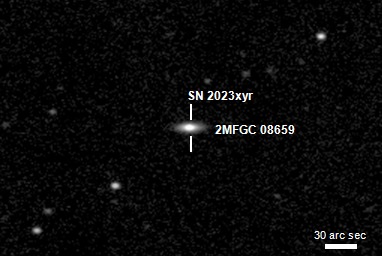 |
| Annotated CCD Image (150% size, square root scale, cropped) 5 x 180s exposure (average combine), 3x3 binning, Clear Filter 2024-02-20 23:15 UT (#1187075-79) 12" LX200R (at f/10.4) + ST-10XME Auto-guided using TS 80mm APO, ZWO ASI178MC & PHD2 |
| Images of SN 2023xyr (in 2MFGC 08659) on Supernova 2023 Page >> |
Back to Top
| IC 1125 with SN 2024jz (Serpens) SN 2024jz (Type: Ia) discovered 2024-01-05.641 UT by ATLAS Alias: ATLAS24ahj Discovery Magnitude 17.73 (orange-ATLAS Filter) ( TNS 2024jz ) |
| IC 1125 with SN 2024jz - 2024-02-21 (T+46.4d) Image below (2024-02-21.085) was taken 46.4 days after discovery of 2024jz Position of reported supernova (fading) is indicated by white cross-hairs. Measured Magnitude +15.75 (Clear Filter) Poor quality image (due to passing cloud / poor sky transparency, moonlit sky) |
 |
| Annotated CCD Image (150% size, square root scale, cropped) 2 x 180s exposure (average combine), 3x3 binning, Clear Filter 2024-02-21 02:07 UT (#1187155-56) 12" LX200R (at f/10.4) + ST-10XME Auto-guided using TS 80mm APO, ZWO ASI178MC & PHD2 |
| Images of SN 2024jz (in IC 1125) on Supernova 2024 Page >> |
Back to Top
| M31 with AT 2024ccb (Andromeda) AT 2024ccb (Type: EGN) discovered 2024-02-10.594 UT by XOSS Alias: PSP24L, PNV J00425721+4119038, ATLAS24chb Discovery Mag 17.74 (Clear Filter) Low S/N spectrum resembles that of a Nova in M31 as already reported by Reguitti et al. (AstroNote 2024-50) ( TNS 2024ccb ) |
| Nova M31 AT 2024ccb - 2024-02-20
(T+10.4d) Image below (2024-02-20.983) was taken 10.4 days after discovery of 2024ccb Position of reported transient (very faint, barely visible) is shown by white cross-hairs Estimated Magnitude +16.0 to +16.5 (Clear Filter) |
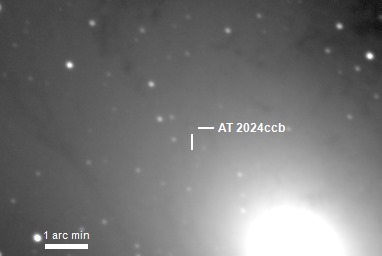 |
| Annotated CCD Image (100% size, square root scale, cropped) 4 x 180s exposure (average combine), 3x3 binning, Clear Filter 2024-02-20 23:44 UT (#1187093-97) 12" LX200R (at f/10.4) + ST-10XME Auto-guided using TS 80mm APO, ZWO ASI178MC & PHD2 |
| Images of Nova AT 2024ccb (in M31) on Transients 2024 Page >> |
Back to Top
| M101 with SN 2023ixf (Ursa Major) SN 2023ixf (Type: IIL) discovered 2023-05-19.727 UT by Koichi Itagaki Alias: ZTF23aaklqou, AT2023iyi, AT2023jgd, AT2023jfz, PSN J14033858+5418421, PS23dij Discoverer Mag 14.9 (Clear filter) ( Rochester Supernova site | TNS 2023ixf ) SN 2023ixf (Type: IIL) discovered 2023-05-19.727 UT by Koichi Itagaki at Mag 14.9 is located near M101's prominant star-forming region NGC 5461. The supernova resulted from a exploding red supergiant and lies just 21 million light years away. It's the closest core-collapse supernova to us since SN 1993J which lit up M81 (some 12 million ly away) in Spring 1993. The SN is designated of type II-L (L for 'linear') , which is characterised by a rapid rise to maximum brightness followed by a slow and gradual decrease, that is thought to be brought about by ejection of the dead stars' outer hydrogen shell. (from Article "Summer's Super Supernova", AstNow Magazine, Sep 2023, pp 36-39) |
| M101 with SN 2023ixf - 2024-02-21 (T+277.4d) Image below (2024-02-21.115) was taken 277.4 days after discovery of 2023ixf Position of supernova (faint but slight brightening ?) is shown by white cross-hairs Measured Magnitude +15.28 (Clear Filter) |
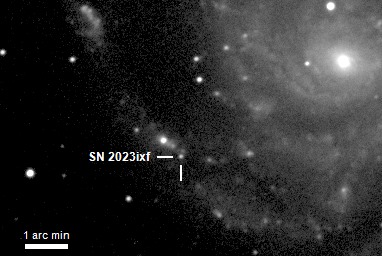 |
| Annotated CCD Image (100% size, square root scale, cropped) 2 x 180s exposure (average combine), 3x3 binning, Clear Filter 2024-02-21 02:49 UT (#1187166-67) 12" LX200R (at f/10.4) + ST-10XME Auto-guided using TS 80mm APO, ZWO ASI178MC & PHD2 |
| Images of SN 2023ixf (M101) on Supernova 2023 Page |
Back to Top
| MCG -1-33-30 with SN 2024byg (Virgo) SN 2024byg (Type: II) discovered 2024-02-08.550 UT by ASAS-SN Alias: ASASSN-24ax Discovery Magnitude 16.3 ( Clear Filter) ( TNS 2024byg ) |
| MCG -1-33-30 with SN 2024byg - 2024-02-21 (T+12.5d) Image below (2024-02-21.035) was taken 12.5 days after discovery of 2024byg Position of reported SN (faint but distinct) is indicated by white cross-hairs. Measured Magnitude +15.90 (Clear Filter) |
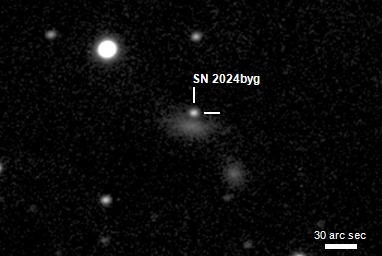 |
| Annotated CCD Image (150% size, square root scale, cropped) 5 x 180s exposure (average combine), 3x3 binning, Clear Filter 2024-02-21 01:00 UT (#1187122-26) 12" LX200R (at f/10.4) + ST-10XME Auto-guided using TS 80mm APO, ZWO ASI178MC & PHD2 |
| Images of SN 2024byg (in MCG -1-33-30) on Supernova 2024 Page >> |
Back to Top
| NGC 3052 with SN 2024chx (Hydra) SN 2024chx (Type: II) discovered 2024-02-12.256 UT by ZTF Alias: ZTF24aaemydm Discovery Magnitude 16.3 ( Clear Filter) ( TNS 2024chx ) |
| NGC 3052 - Spiral Galaxy with SN 2024chx (T+8.8d |
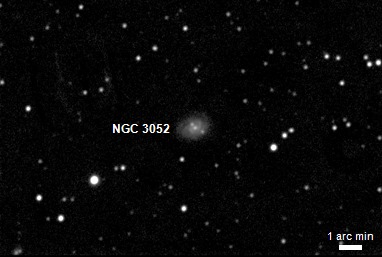 |
| Annotated CCD Image (50% size, square root scale) 5 x 180s exposure (average combine), 3x3 binning, Clear Filter 2024-02-21 00:37 UT (#1187114-18) 12" LX200R (at f/10.4) + ST-10XME Auto-guided using TS 80mm APO, ZWO ASI178MC & PHD2 |
| NGC 3052 with SN 2024chx - 2024-02-21 (T+8.8d) Image below (2024-02-21.020) was taken 8.8 days after discovery of 2024chx Position of reported SN (faint but distinct) is indicated by white cross-hairs. Measured Magnitude +15.94 (Clear Filter) |
 |
| Annotated CCD Image (150% size, square root scale, cropped) 5 x 180s exposure (average combine), 3x3 binning, Clear Filter 2024-02-21 00:37 UT (#1187114-18) 12" LX200R (at f/10.4) + ST-10XME Auto-guided using TS 80mm APO, ZWO ASI178MC & PHD2 |
| Images of SN 2024chx (in NGC 3052) on Supernova 2024 Page >> |
Back to Top
| NGC 3206 with SN 2024bch (Ursa Major) SN 2024bch (Type: IIn) discovered 2024-01-29.252 UT by Patrick Wiggins Alias: ATLAS24bmx, PS24aap, GOTO24hm Discovery Magnitude 15.5 ( Clear Filter) ( TNS 2024bch ) |
| NGC 3206 with SN 2024bch - 2024-02-20 (T+22.7d) Image below (2024-02-20.906) was taken 22.7 days after discovery of 2024bch Position of reported SN (relatively bright & distinct) is indicated by white cross-hairs. Measured Magnitude +13.41 (Clear Filter) |
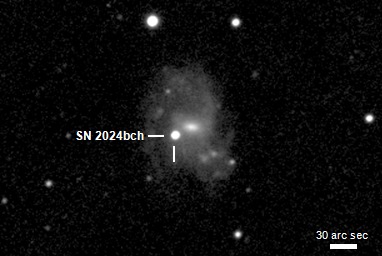 |
| Annotated CCD Image (125% size, square root scale, cropped) 5 x 180s exposure (average combine), 3x3 binning, Clear Filter 2024-02-20 21:54 UT (#1187048-52) 12" LX200R (at f/10.4) + ST-10XME Auto-guided using TS 80mm APO, ZWO ASI178MC & PHD2 |
| Images of SN 2024bch (in NGC 3206) on Supernova 2024 Page >> |
Back to Top
| NGC 3893 with AT 2023uhx (Ursa Major) AT 2023uhx (Type: LRN) discovered 2023-10-07.816 UT by Koichi Itagaki Discovery magnitude 17.2 (Clear filter) vs DSS Archival Image Luminous Red Nova based on its peak luminosity, and narrow Balmer and Fe II emission lines. ( TNS 2023uhx) |
| NGC 3893 with AT 2023uhx - 2024-02-20 (T+136.0d) Image below (2024-02-20.858) was taken 136.0 days after discovery of 2023uhx Position of reported transient (very faint) is shown by white cross-hairs Measured Magnitude +18.48 (Clear Filter) |
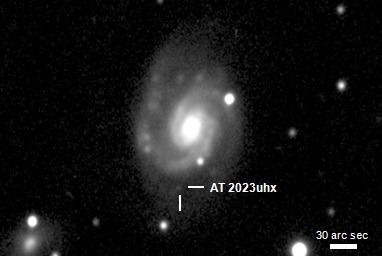 |
| Annotated CCD Image (125% size, square root scale, cropped) 4 x 180s exposure (average combine), 3x3 binning, Clear Filter 2024-02-20 20:42 UT (#1187014-17) 12" LX200R (at f/10.4) + ST-10XME Auto-guided using TS 80mm APO, ZWO ASI178MC & PHD2 |
| Images of AT 2023uhx (NGC 3893) on Transients 2023 Page >> |
Back to Top
| NGC 4216 with SN 2024gy (Virgo) SN 2024gy (Type: Ia, z=0.001183) discovered 2024-01-04.678 UT by Koichi Itagaki Alias: AT2023acjv, AT2024ix, ASASSN-24ac, PSN J12155131+1306561 Discovery Magnitude 16.3 ( Clear Filter) ( TNS 2024gy ) |
| NGC 4216 with SN 2024gy - 2024-02-20 (T+47.2d) Image below (2024-02-20.873) was taken 47.2 days after discovery of 2024gy Position of reported SN (distinct, fading) is indicated by white cross-hairs. Measured Magnitude +13.93 (Clear Filter) |
 |
| Annotated CCD Image (100% size, square root scale, cropped) 5 x 180s exposure (average combine), 3x3 binning, Clear Filter 2024-02-20 21:06 UT (#1187023-27) 12" LX200R (at f/10.4) + ST-10XME Auto-guided using TS 80mm APO, ZWO ASI178MC & PHD2 |
| Images of SN 2024gy (in NGC 4216) on Supernova 2024 Page >> |
Back to Top
| NGC 6004 with SN 2024cld (Serpens) SN 2024cld (Type: II) discovered 2024-02-13.228 UT by GOTO Alias: GOTO24ql, ATLAS24clv Discovery Magnitude 17.97 ( Clear Filter) Spectrum contains clear narrow H Balmer and He II 4686A flash ionisation features typically seen in young type II SNe ( TNS 2024cld ) |
| NGC 6004 with SN 2024cld - 2024-02-21 (T+7.9d) Image below (2024-02-21.094) was taken 7.9 days after discovery of 2024cld Position of reported SN (distinct, & brightening ?) is indicated by white cross-hairs. Measured Magnitude +15.14 (Clear Filter) |
 |
| Annotated CCD Image (150% size, square root scale, cropped) 2 x 180s exposure (average combine), 3x3 binning, Clear Filter 2024-02-21 02:18 UT (#1187159-60) 12" LX200R (at f/10.4) + ST-10XME Auto-guided using TS 80mm APO, ZWO ASI178MC & PHD2 |
| Images of SN 2024cld (in NGC 6004) on Supernova 2024 Page >> |
Back to Top
| SN 2023nj (Hydra) SN 2023nj (Type: Ia) discovered 2023-01-13.380 UT by ZTF Alias: ZTF23aaajtan Discovery Magnitude 19.33 ( Clear Filter) ( TNS 2023nj ) |
| SN 2023nj - 2024-02-20 (T+403.6d) Image below (2024-02-20.940) was taken 403.6 days after discovery of 2023nj Position of earlier SN (faded & no longer visible) is indicated by white cross-hairs. Non-Detection Limiting Magnitude +18.5 (Clear Filter) |
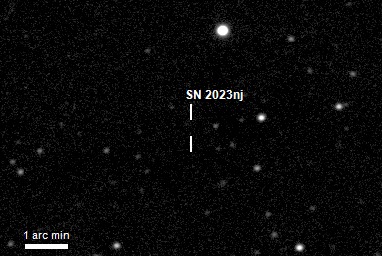 |
| Annotated CCD Image (100% size, square root scale, cropped) 4 x 180s exposure (average combine), 3x3 binning, Clear Filter 2024-02-20 22:42 UT (#1187060-64) 12" LX200R (at f/10.4) + ST-10XME Auto-guided using TS 80mm APO, ZWO ASI178MC & PHD2 |
| Images of SN 2023nj on Supernova 2023 Page >> |
Back to Top
| This Web Page: | CCD Images - Session 1187 (2024-02-20) |
| Last Updated : | 2024-04-13 |
| Site Owner : | David Richards |
| Home Page : | David's Astronomy Web Site |